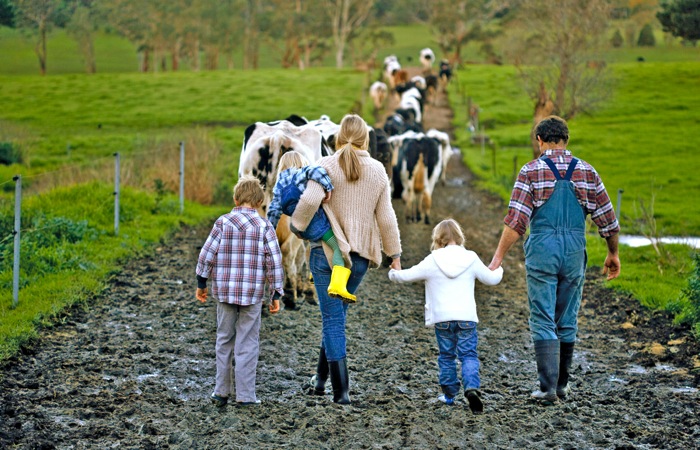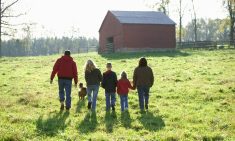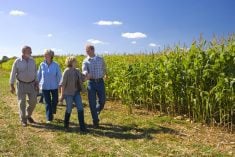An entire industry has built up to support farm succession planning. And for good reason. With a typical farm in Canada worth millions of dollars and requiring numerous staff, and with so many farms having related businesses and supporting two or more families, transition of the business to the next generation involves a lot more than a handshake and a slap on the back.
Just don’t look for a lot of statistics or hard numbers about how many farms are going through succession, or how many billions of dollars’ worth of assets they’re discussing.
Read Also

Producers aren’t panicking over tariffs and trade threats
The influence of tariff and trade uncertainity on farm business decisions.
This may be the biggest phenomenon that Canadian agriculture has ever witnessed, but neither the federal government nor the ag universities nor anyone else really has a good handle on just how big it is. And no one really has a good handle on how well farmers are doing at meeting the challenge.
Anecdotal evidence, of course, is as common as mailboxes all across rural Canada.
“Statistics Canada does have some good data on farm operators,” says James Bryan, senior agricultural economist with Farm Credit Canada in Regina. “As does the Canadian Federation of Agriculture.”
There are estimated to be over 140,000 farm operators over the age of 55 still actively farming in some way on something in the neighbourhood of 17,500 farms.
It’s thought they control something in excess of $50 billion in farm assets, much of which will change hands over the next 10 years.
It’s also recognized that the ability of the successor to service the debt required to buy the farm is a real issue, and that increasingly, it is an issue that can take many decades to resolve, with serious implications for both the retiring and the successor generation.
Just to state the obvious, servicing a large debt can restrict the new farmer’s ability to make the best business and production decisions for his or her particular situation.
The good news is that many farmers are stepping up to the plate.
“My experience spans over 40 years, but in the last decade I find more and more farm families are realizing the importance of the succession plan process,” says Len Davies, principal of Davies Legacy Planning Group Inc. “They are focusing on issues beyond just tax planning, but looking at tailoring a business plan and strategy that takes into account family dynamics as well as the business itself.”
They’re even coming to accept some of the hardest truths. “The failed farm succession,” Davies says, “is not the fault of an accountant who made a mistake. Rather it usually is a result of some breakdown in the family itself.”
- More from Country Guide: Taking the first steps in succession planning
More push, more pull
“Farming has become sexier,” says Lance Stockbrugger, a chartered accountant, consultant and full-time farmer of 4,000 acres in east-central Saskatchewan. “In recent years, it has become a viable and desirable option for the next generation, and it is preparing itself accordingly.”
The next generation of farmers is pursuing a rigorous education in agriculture combined with usually, but not always, off-farm employment to gain independence, skills and a greater appreciation for the industry before it makes the decision to come back to the farm.
“The added difficulty with farming now being an attractive job and lifestyle, is that not only does one child want to farm, they may all want to,” Stockbrugger says. “How does the farm handle that? How can Mom and Dad and the kids figure out who gets to farm and who does not, and how to make that fair?”
There’s also more pressure for comprehensive succession planning, Stockbrugger says. “This is accomplished by thinking through how every major decision they make is going to affect the succession of their business.”
It also means looking reality in the eye. It may be that not all the children who would like to farm will be able to. “Try to make decisions that will make it easier to transition farm assets later on” says Stockbrugger. “As more family members become involved in the operation, more income is needed to provide for those families. This can be accomplished by having less custom work done such as trucking products to market, agronomy services and so on. Income could also be created by thinking outside the box entirely and starting new ventures — purchasing equipment for custom work or finding work for existing equipment outside of non-peak times.”
However, when Stockbrugger conducts succession seminars and planning sessions for Farm Credit Canada, he still finds the audience is a “roomful of grey hairs.”
“There should be 20- and 30-year-olds in the audience, especially if they themselves have families,” Stockbrugger says. “Like saving for retirement, planning for a succession and having 30 to 40 years to do so gives you much greater ability to get your ducks in a row.”
Another advantage of thinking about and planning for succession with decades left on the clock is that more consideration can be given to farm business structures. “Corporations are the lowest-taxed business structures,” says Stockbrugger. “But it is very difficult to transition assets and land, especially to more than one successor and especially if those two are not going to be farming together.”
Stockbrugger usually likes to advise that the land be kept out of the corporation and a family trust be created to own the shares of the corporation. “While this is more costly to set up, it really does pay off in spades down the road with the flexibility it offers,” he explains. “Ownership structure should get a lot of attention very early on in the process.”
Finding a way to talk
The message has gotten out that open and honest communication within the family about goals and aspirations is just as important — or even more important — than the financial aspects of the succession.
“Successors need to explore where they have deficiencies, for instance in financial management or human resource management,” says Davies. “Once identified, these deficiencies can be worked on through training, off-farm employment opportunities, or mentoring.”
Indeed, in today’s environment, continuous skill development over the entire course of a farmer’s career is vitally important. Technology is changing in farming at an incredible rate, and if the farm doesn’t keep up with advances in technology or agronomy or anything else, it risks being left behind and becoming unprofitable.
“Failed successions, in my experience, have little to do with the business structure or the transition of assets,” says Stockbrugger. “Failed successions are often due to a lack of management training — the young farmer who has never had to spend $400,000 on a new combine or $20,000 on a repair. It can be overwhelming and despite their skills as an agronomist or operator, if they can’t manage the financials, failure is certainly a risk.”
Another bigger change in the last number of years as the business of farming has provided better, more reliable returns is farmers realizing that they need to work on the farm, not just at “farming.”
“Where is the farm business going to be in five years, 20 years?” asks Davies. “What needs to change when there are marriages, additions to the families and, unfortunately, farmers are not immune to divorce? These are all areas that should be considered and planned for.”
Another longtime practitioner and educator in the field of farm succession is Terry Betker, president and CEO of Backswath Management. He also lectures at the University of Manitoba and has lived through two farm successions of his own.
“In the last four to five years, the biggest change I’ve observed, for the first time maybe, is the accumulation of wealth in farm families and the impact that is having on succession,” says Betker. “We’ve seen this accumulation of wealth on the farm elsewhere in the EU and even eastern Canada, but now it is becoming the Western Canadian experience.”
Transitioning ownership and management in this environment and being fair and equal to everyone requires a lot of thought, planning and time. “Farms are also more complex these days,” notes Betker. “The size of the business, the structure of the business and the human resources required to run the business can be as involved as any non-farming business of equal capitalization.”
The leadership challenge
Betker believes a much greater understanding of leadership is necessary to execute a successful transition. “Farmers are realizing, whether they like it or not,
that they have to spend less time on a tractor and more time at a desk,” says Betker. “This is a challenge for a lot of folks who are in this business because they truly love the work of farming, the outdoors, the machinery, the crops and animals and so on.”
Back in the early ’90s, awareness of succession planning was building. It really hit the radar later that decade as the farming population aged. The 2001 census showed there was a larger percentage of farmers over 55 years of age that in previous censuses.
“Now people are more aware that they should have some greater formality around the succession question,” says Betker.
Now, however, the pendulum may in a way have swung too far. “I think it may have gotten to the point,” says Betker, “where there is now some mystique about succession, and maybe they overthink it.”
While there are no black and white answers to the questions of succession, it’s also not rocket science. The biggest question or conundrum to solve is how the non-farming children are going to be treated.
“I am seeing more and more situations where the non-farm children retain some ownership in the farm business as shares, for instance,” says Betker. “There can be buyouts or exchanges of cash over time, or right away, as well. It really is for the family to determine their best strategy to keep the family on the same page.”
Another common theme is the retiring generation retaining or being advised to retain ownership in the farm. “Their continued ownership is their best risk mitigation strategy towards their own retirement and the continued success of the farm,” says Betker.
Betker also agrees with Stockbrugger and Davies that succession planning should be entrenched in good farm business management.
“Every investment and every strategy should be undertaken with a view to positioning the farm for the next generation,” says Betker. “I am finding that lenders are also moving in that direction. They are very interested in the long term view because that is just plain good business management.”
This article first appeared as, “Getting there from here,” in a special section called Succession in Agriculture in the September 2014 issue of Country Guide.















